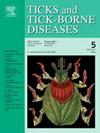Prevalence of Rickettsia species phylotype G022 and Rickettsia tillamookensis in Ixodes pacificus nymphs and adults from Northern California
IF 3.4
2区 医学
Q2 INFECTIOUS DISEASES
引用次数: 0
Abstract
Ticks are known vectors of various pathogenic bacteria, including species of Rickettsia. Two novel Rickettsia species have been identified in adult Ixodes pacificus: Rickettsia species phylotype G022 in 2011 and R. tillamookensis in 2021. Currently, the pathogenic potential of these species found in I. pacificus remains unknown. This study aimed to determine the prevalence of phylotype G022 and R. tillamookensis in I. pacificus nymphs across different mean annual temperature and relative humidity zones in California. Adult ticks were also tested for phylotype G022. Ticks were collected from multiple locations in seven northern California counties and tested by real-time PCR. The overall prevalence of phylotype G022 and R. tillamookensis in nymphs (n = 550) was 5.3 % (95 % CI = 3.7 %-7.5 %) and 1.6 % (95 % CI=0.8 %–3.3 %), respectively. The overall prevalence of phylotype G022 in adult I. pacificus (n = 720) was 9.0 % (95 % CI = 7.2 %-11.3 %). Phylotype G022 infects nymphal I. pacificus across a broad geographic range. The prevalence of phylotype G022 was higher in the 11.7–13.3 °C (53–56°F) temperature zone, at 6.4 % (95 % CI = 4.5 %-9.2 %), compared to the 13.9–15 °C (57–59°F) zone, where the prevalence was 0.8 % (95 % CI = 0.2 %-4.6 %). In contrast, the prevalence of R. tillamookensis did not show a statistically significant difference between the two temperature zones, with 1.9 % (95 % CI = 0.9 %-4.1 % in the 11.7–13.3 °C (53–56°F) zone and 0.9 % (95 % CI = 0.2 %-4.9 %) in the 13.9–15 °C (57–59°F) zone. The detection of phylotype G022 in both questing nymphs and adults of I. pacificus suggests that it is transmitted transstadially. qPCR testing revealed no coinfections of G022 and R. tillamookensis in any of the nymphs. Although R. tillamookensis exhibited a lower overall prevalence in nymphs compared to phylotype G022, both bacteria exhibited a similar geographic distribution.
G022种立克次体和替拉莫肯氏立克次体在北加州太平洋伊蚊若虫和成虫中的流行。
蜱是各种致病菌的已知媒介,包括立克次体。在太平洋伊蚊成虫中发现了两个新的立克次体种:2011年发现的G022立克次体种和2021年发现的蒂拉莫肯氏立克体种。目前,这些物种的致病潜力尚不清楚。本研究旨在确定G022型和蒂拉莫肯氏弧菌在加州不同年平均温度和相对湿度带的太平洋鼢鼠若虫中的流行情况。对成蜱进行了G022种型检测。蜱虫从加州北部七个县的多个地点收集,并通过实时PCR进行检测。550名若虫中G022型和蒂拉莫肯氏弧菌的总患病率分别为5.3% (95% CI= 3.7% ~ 7.5%)和1.6% (95% CI= 0.8% ~ 3.3%)。成虫(n = 720) G022型总体患病率为9.0% (95% CI = 7.2% ~ 11.3%)。种型G022在广泛的地理范围内感染太平洋I.。G022型在11.7-13.3°C(53-56°F)温度区域的患病率较高,为6.4% (95% CI = 4.5% - 9.2%),而在13.9-15°C(57-59°F)区域的患病率为0.8% (95% CI = 0.2% - 4.6%)。相比之下,蒂拉莫肯氏杆菌的患病率在两个温度区域之间没有统计学上的显著差异,11.7-13.3°C(53-56°F)区域为1.9% (95% CI = 0.9% - 4.1%), 13.9-15°C(57-59°F)区域为0.9% (95% CI = 0.2% - 4.9%)。G022型在太平洋棘球绦虫若虫和成虫中均有检测,提示其可经横切传播。qPCR检测结果显示,所有若虫均未同时感染G022和蒂拉莫肯氏孢子虫。尽管与G022种型相比,蒂拉莫肯菌在若虫中的总体流行率较低,但两种细菌的地理分布相似。
本文章由计算机程序翻译,如有差异,请以英文原文为准。
求助全文
约1分钟内获得全文
求助全文
来源期刊

Ticks and Tick-borne Diseases
INFECTIOUS DISEASES-MICROBIOLOGY
CiteScore
6.90
自引率
12.50%
发文量
185
审稿时长
6-12 weeks
期刊介绍:
Ticks and Tick-borne Diseases is an international, peer-reviewed scientific journal. It publishes original research papers, short communications, state-of-the-art mini-reviews, letters to the editor, clinical-case studies, announcements of pertinent international meetings, and editorials.
The journal covers a broad spectrum and brings together various disciplines, for example, zoology, microbiology, molecular biology, genetics, mathematical modelling, veterinary and human medicine. Multidisciplinary approaches and the use of conventional and novel methods/methodologies (in the field and in the laboratory) are crucial for deeper understanding of the natural processes and human behaviour/activities that result in human or animal diseases and in economic effects of ticks and tick-borne pathogens. Such understanding is essential for management of tick populations and tick-borne diseases in an effective and environmentally acceptable manner.
 求助内容:
求助内容: 应助结果提醒方式:
应助结果提醒方式:


